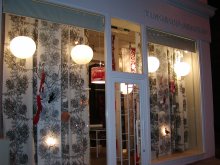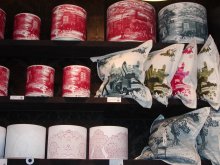Brave new fabrics, brave new walls: exploring the world of Timorous Beasties
by anna battista

It was in the second half of the 1700s that the Remondinis – a family of printers from Bassano del Grappa - started producing a type of paper used to decorate walls. The market for their wallpapers soon became lively: the theatre La Fenice in Venice was indeed covered with the famous wallpapers from Bassano del Grappa, and, years later, the Remondinis also started exporting their products abroad.
Fast-forward to the 1990s when two textile designers, Alistair McAuley and Paul Simmons, founded a company in Glasgow that - characterised perhaps by the same passion for printing and originality that were the Remondinis’ trademarks - reinvented the world of hand-printed wallpapers, fabrics and blinds. Enter Timorous Beasties.
The company first started designing fabrics and wall coverings for bars, clubs and restaurants, as well as designing for large European furnishing companies such as Sahco Hesslein, Warner Fabrics, Dedar and Boussac. Other projects ranged from designing interiors for hotels to furniture: The Strata Bar and The Arches theatre, both in Glasgow, are two of the projects Timorous Beasties worked on with fellow designers One Foot Taller; more recently the company designed the set for BBC2’s "The Beat Room", rollershades for the Ogilvey and Mather building in Dublin, and the interiors of the London casino Fifty.
The company set up a shop in Glasgow’s Great Western Road around a year ago. Here you can buy Timorous Beasties’ wallpapers and fabrics, but also lampshades, cushions, or works by other artists such as Donna Wilson, Alex Taylor and many more. Step into the shop and you’ll soon be drawn into a surreal world made of sheets of wallpaper and drapes of materials hanging from the ceiling: giant bees, huge butterflies, thorny thistles or sensual fuchsia orchids adorn some of the wallpapers; iguanas and scary looking pheasants stare back at you from the fabrics. Then there is the infamous Glasgow toile.

Produced from 1760 on in France by the Manufacture Royale de Jouy to compete with the painted and printed cotton fabrics imported from India, the Toile de Jouy textile was originally available in two models, one featuring polychrome floral designs, the other monochrome scenes with figures. Timorous Beasties’ Glasgow toile looks at first glance very similar to the monochrome scenes toile, but, on close inspection, you’ll discover that, rather than pastoral or rural scenes, it features sinister images of addicts shooting up in the Necropolis, tramps sleeping on park benches and a young lad clad in a tracksuit peeing against some bushes, while, in the background, you can spot the Glasgow University Tower, the Charles Rennie Mackintosh Church and the Armadillo building.
The purpose of the Beasties’ toile is to satirize the world of textiles, updating the context of the Toile de Jouy. The second toile and the latest creation for what regards fabrics is the London toile, the result of a collaboration between furniture company SCP and Timorous Beasties. The new London Toile print by Timorous Beasties was used to adorn the Slow sofa by Terence Woodgate exhibited, together with the Balzac and Wing armchairs by Matthew Hilton covered in Timorous Beasties custom damask patterns, at the 2005 London Design Festival. “Our toile is an uncommercial idea because of the imagery it has - think about the junky - but what is great about it is that it has sold reasonably well and it has lead to other toile ideas,” Paul Simmons states, “you could indeed have a toile a year done using images of other cities all around the world.”
According to Paul, the worst jobs for Timorous Beasties are the ones in which you have to hang up the same wallpaper and, of all the projects they worked on so far, the most stimulating is the one they are concentrating upon right now, a window display for The Wellcome Trust, an independent charity funding research to improve human and animal health. “The project will be on display in London and will incorporate all the things that we like, such as weird and wonderful imagery, like eyeballs, spinal chords, brains, blood vessels and giant syringes,” Paul says, “it’s not hugely different perhaps from things we’ve done before - the processes we work with are the same, and we use the same kind of language in all our creations, such as the ideas of repetition and patterns - but there aren’t so many commercial constraints on this project and this makes it great.”
Paul announces that, among the future plans for next year, there is also an exhibition in New York, and that, in 2006, Timorous Beasties aren’t going to go experimental, “We’re just going to go mental,” he explains, smiling, “at the moment we are working on a different material, lace manufacture. I like working with things people have preconceived ideas about. The first thing that comes to people’s minds when you say the word ‘lace’ is old granny’s knickers, while if you mention the word ‘wallpaper’, they’ll think about some kind of bad wallpaper they saw in B&Q. What we’re trying to do and what we’ll keep on doing next year is rethinking what people have got embedded in their minds and presenting it in a new form.”
Like their printing ancestors the Remondinis, Timorous Beasties have entered history, thanks to their boldly patterned sensual fabrics and wallpapers and their provocative and sumptuous textiles. If want to refurnish your bar, shop, office, hotel or simply your house, and feel adventurous and daring, now you know who you should turn to.
[Photographs of the Timorous Beasties shop in Glasgow, Scotland, by Anna Battista]
Copyright (c) 2005 erasing clouds |
|